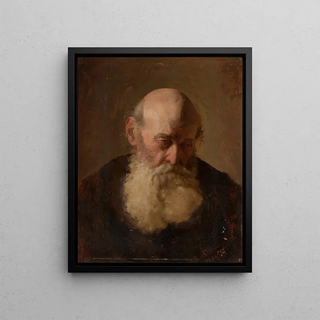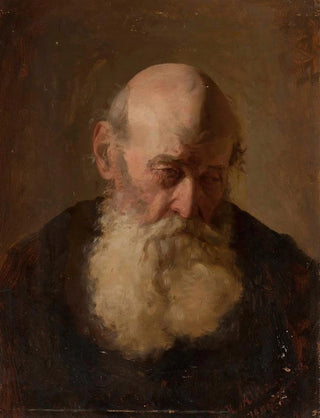Art print | Study of an old man's head - Kazimierz Alchimowicz


View from behind

Frame (optional)
"Study of an Old Man's Head" by Kazimierz Alchimowicz offers a captivating glimpse into the world of portraiture and human expression. This artwork, both intimate and universal, invites us to explore the nuances of human life through the face of an elderly man. The depth of the features and the intensity of the gaze capture wisdom and melancholy, reflecting a life marked by the passage of time. In this art print, the artist succeeds in conveying a palpable emotion, making the viewer a silent witness to this encounter with a past full of stories. It is a suspended moment that prompts reflection on our own relationship with time and memory.
Style and uniqueness of the work
Alchimowicz's style is distinguished by a realistic and almost tactile approach to textures. Every detail, whether the softness of the skin or the roughness of the wrinkles, is rendered with precision that evokes a sense of life. The interplay of shadow and light creates a dramatic atmosphere, accentuating facial features and revealing hidden emotions. This realism is not limited to a simple physical representation; it also explores the human soul. Through this study, Alchimowicz manages to transcend mere portraiture to offer a reflection on the human condition, on the passage of time, and lived experiences. The color palette, subtle and nuanced, contributes to the visual impact of the art print, adding an almost spiritual dimension to this face marked by life.
The artist and his influence
Kazimierz Alchimowicz, a Polish artist, established himself in the art world through his unique approach to portraiture. His training and background allowed him to explore various styles and techniques, but it is in realism that he finds his true voice. Alchimowicz draws inspiration from masters of the past while incorporating contemporary sensibilities, enabling him to reach a broad audience. His work is not only a technical study but also a testament to his era, questioning notions of identity and memory. By highlighting often forgotten figures, he gives a voice to

Matte finish

View from behind

Frame (optional)
"Study of an Old Man's Head" by Kazimierz Alchimowicz offers a captivating glimpse into the world of portraiture and human expression. This artwork, both intimate and universal, invites us to explore the nuances of human life through the face of an elderly man. The depth of the features and the intensity of the gaze capture wisdom and melancholy, reflecting a life marked by the passage of time. In this art print, the artist succeeds in conveying a palpable emotion, making the viewer a silent witness to this encounter with a past full of stories. It is a suspended moment that prompts reflection on our own relationship with time and memory.
Style and uniqueness of the work
Alchimowicz's style is distinguished by a realistic and almost tactile approach to textures. Every detail, whether the softness of the skin or the roughness of the wrinkles, is rendered with precision that evokes a sense of life. The interplay of shadow and light creates a dramatic atmosphere, accentuating facial features and revealing hidden emotions. This realism is not limited to a simple physical representation; it also explores the human soul. Through this study, Alchimowicz manages to transcend mere portraiture to offer a reflection on the human condition, on the passage of time, and lived experiences. The color palette, subtle and nuanced, contributes to the visual impact of the art print, adding an almost spiritual dimension to this face marked by life.
The artist and his influence
Kazimierz Alchimowicz, a Polish artist, established himself in the art world through his unique approach to portraiture. His training and background allowed him to explore various styles and techniques, but it is in realism that he finds his true voice. Alchimowicz draws inspiration from masters of the past while incorporating contemporary sensibilities, enabling him to reach a broad audience. His work is not only a technical study but also a testament to his era, questioning notions of identity and memory. By highlighting often forgotten figures, he gives a voice to






